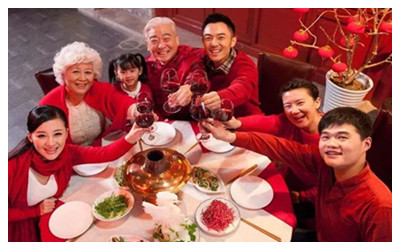Skype: neodalle-travel
Tel: +86 135 7447 2266
E-mail: sales@visitaroundchina.com

Dinner of Chinese New Year’s Eve
Chinese New Year's Eve is extremely important for Chinese people. On this day, people ring out the Old Year and ring in the New Year, then eat the reunion dinner.
 Eating New Year's Eve dinner is the most popular New Year enjoyable time for each family. On New Year’s Eve, the dinner table are filled with various dishes and family reunion, sitting around the table were happy to eat there meal on the table. There are many kind of dishes including hot dishes, cold dishes, dissert and various staple food. However, there are two general two things: hot pot and fish. The hot pot is boiling and steaming, warm and sultry, indicating prosperous future; "fish" and "surplus" are homophonic in Chinese which is a symbol of "more than auspicious", but also a metaphor for "surpluses every year." Turnips are commonly known as radish which means a good beginning in the coming year. Lobster, fish and other fried foods wish a thriving family fortune like "fire cooking oil." There are many different customs of celebrating New Year’s Eve in different parts of China, the staple food in different place various from dumplings, noodles to sweet dumplings.
Eating New Year's Eve dinner is the most popular New Year enjoyable time for each family. On New Year’s Eve, the dinner table are filled with various dishes and family reunion, sitting around the table were happy to eat there meal on the table. There are many kind of dishes including hot dishes, cold dishes, dissert and various staple food. However, there are two general two things: hot pot and fish. The hot pot is boiling and steaming, warm and sultry, indicating prosperous future; "fish" and "surplus" are homophonic in Chinese which is a symbol of "more than auspicious", but also a metaphor for "surpluses every year." Turnips are commonly known as radish which means a good beginning in the coming year. Lobster, fish and other fried foods wish a thriving family fortune like "fire cooking oil." There are many different customs of celebrating New Year’s Eve in different parts of China, the staple food in different place various from dumplings, noodles to sweet dumplings.
The family is the foundation of Chinese society. The annual reunion dinner fully demonstrates that the Chinese clan family members love each other and this mutual respect and love also brings the relationship between the families closer together.
Reunite families often make householders get spiritual consolation and satisfaction. The elders look at dons, daughters and grandchildren while the whole family gather at the table. The care and upbringing of children in the past finally paid off which is a kind of happiness that cannot be too much praised. The younger generation are also able to take the opportunity to raise the grace to parents and express gratitude.
On New Year's Eve, people get rid of the old and welcome the New Year. And it is also a good time is for the children to learn the traditional Spring Festival and the best time to accept traditional education.
 Ask Questions ?
Ask Questions ?